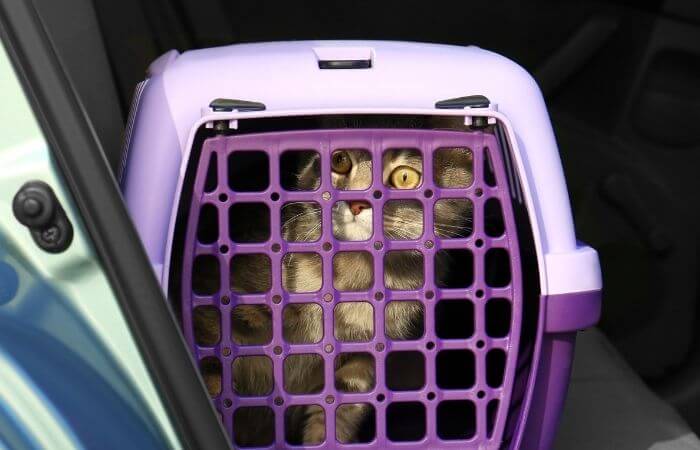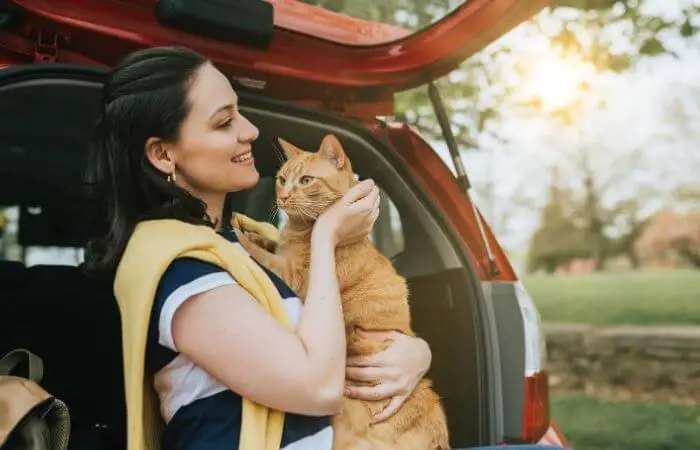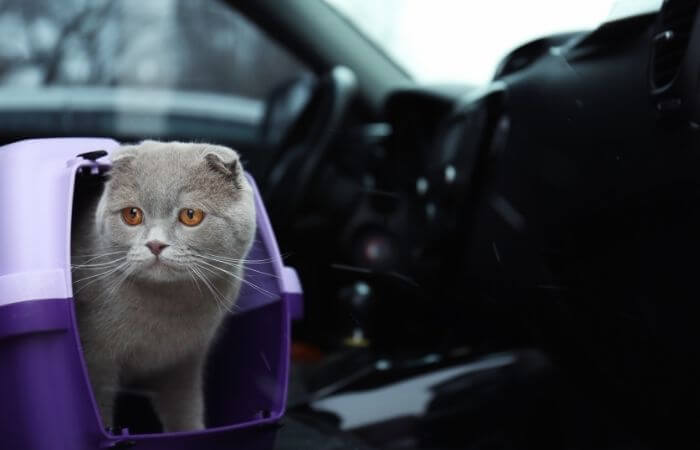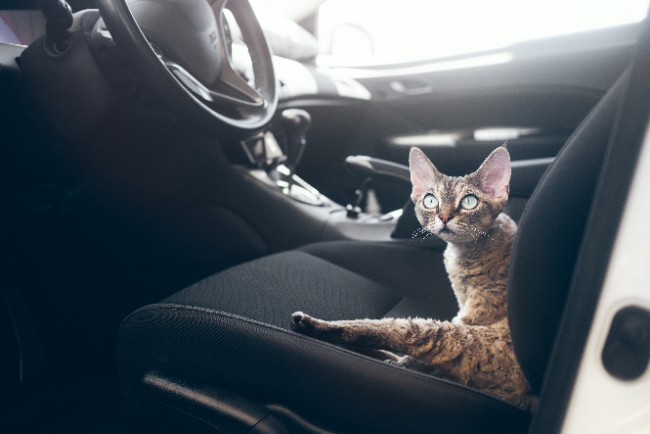Many cats don’t enjoy travelling or going in a car. This is mostly due to the unfamiliar and unpredictable nature of the situation.
The majority of cats seem to be happiest with all four paws safely on steady ground at home, but sometimes there is a good reason for them to travel.
The best thing you can do to help your cat be calm in the car is to ensure they see their carrier as both a happy and a familiar place.
This guide will help you keep your cat calm so you can take them wherever you need to go without high levels of stress or anxiety.
Contents
1. Use A Good Cat Carrier
First things first, you don’t want your cat to be freely moving around the car while you travel. A carrier is essential for you and your cat’s safety.

If used correctly, the carrier also acts as a calming tool.
The carrier should be large enough for your cat to comfortably be able to stand up and turn around but it should not be too spacious.
In order for the carrier to have a positive impact, your cat needs to be familiar with it.
It should be a carrier they have explored in their own time and they should associate it with being a safe place.
Avoid Only Getting The Carrier Out On The Day Of A Trip/ Vet Visit
One of the worst mistakes pet owners make is only letting their pets see and experience the carrier when they need to go to the vets etc.
This causes pets to become immediately stressed when they see the carrier appear from storage.
Avoid this by letting your cat spend time in the carrier on their own accord and give them treats whenever they do.
This helps to build a positive association between your cat and their carrier.
Let Your Cat Familiarise Themselves With Their Carrier
If the carrier is brand new or your cat has simply not had a chance to familiarise themselves with it, make sure you do this in the days/ weeks before the planned car journey.
Simply place the open carrier in a centralised location of the house, place some familiar toys or blankets inside and let your cat explore it as and when they feel like it.
Once your cat has become comfortable going into the carrier, close the door for short periods of time so they can get used to this as well.
Taking the time for this kind of preparation before travelling with your cat ensures your trip is starting on a solid foundation.
It is helping to set you up for success so is a step you definitely should not skip.
2. Take A Familiar Blanket Or Towel
Putting a towel or blanket that smells like your cat into the car and carrier can help them feel a lot more comfortable.

This helps to bring the smells of home with you and this will help calm your cat.
Remember, you want the carrier to be comfortable, secure and familiar.
Having it smell like home and your cat will go a long way in settling any nerves your cat has.
3. Use A Calming Cat Aid
If your cat gets particularly anxious when in new situations, consider offering herbs such as valerian root to help calm them.

Valerian root will help put your cat into a calm, docile state and may also encourage them to sleep.
This is a great way of encouraging your cat to relax and sleep without giving medication.
For best results, give the valerian to your cat about 10-15 minutes before you plan to go in the car.
This gives enough time for your cat to start relaxing and will mean they will be feeling extremely chilled out when it’s time to go in the car.
Other options include pheromone sprays and catnip.
If your cat is very stressed and anxious, you can also speak to a vet about anxiety medication for the days you need to transport your cat.
4. Cover The Carrier With Breathable Fabric
This tip is dependent on each individual cat.
Some cats may like to be able to see you and see what’s going on while others may become distressed by the constantly changing light and scenery.
If you feel it will help your cat relax, you can place a breathable towel or lightweight blanket over the carrier to reduce how much your cat can see.
5. Ensure The Car Temperature Is Comfortable
Before getting into the car, make sure it is not too hot or too cold.

Be mindful of the temperature and the weather so you can make the relevant adjustments to the car temperature before putting your cat in the car.
The ideal car temperature for a cat is between 23-30°C (75-85°F).
Don’t leave your cat in the car alone and keep an eye on them as if they start panting this could be a sign they are overheating or could mean they are anxious.
6. Go On Short Journeys First
Slowly introducing your cat to being in the car is the best approach.

Driving to the vets on the first time your cat goes in the car is going to increase stress and cause negative association.
Instead, the first couple of times in the car just go for a short drive around the block so your cat can get used to the sensation.
Always reward your cat with treats after a car journey so they begin to associate it with positive experiences.
On The Day Of The Journey
Below are a couple of extra tips to keep in mind on the day of the car ride.
Give Your Cat Lots Of Attention In The Hours Before The Car Ride
Playing with your cat and giving them lots of snuggles before you go in the car will help your cat feel good and will also help tire them out for later.
This extra love will help the car ride go more smoothly.
Don’t Feed Your Cat Before The Journey
If your cat has just eaten they are more likely to experience motion sickness.
Travelling on an empty stomach will reduce nausea so keep their meals light to help them have a comfortable travel experience.
During The Journey
When you have followed all the above advice and you’re now in the car with your cat safely in their carrier, you may be wondering if there is anything else you can do during the drive to help your cat relax.
Below are some top tips for the journey:
Talk To Your Cat
Being in the car and experiencing a lot of unfamiliarities can make a cat feel unsure and nervous but if they can hear your voice it will help relax them.
Calmly talk to your cat throughout the journey so they know that you are there.
You can also position the carrier so your cat is able to see you too. Whenever you stop, you can give your cat additional reassurance by stroking them through the carrier.
Play Calming Music
Some cat owners say that playing classical music helps to keep their cat calm during journeys. Different cats will have different reactions to this but it is certainly worth a try.
Calming music can help cover the noise of the engine and your cat might like it. Equally, your cat might prefer it to be quiet so just see how they respond.
Don’t Rush
Make sure you give yourself enough time. Feeling rushed will make you feel stressed and your cat will pick up on this. It’s best to get everything else sorted before moving your cat into the car.
Drive Carefully
Your cat will be sensitive to the movement so drive carefully to make the journey as pleasant as possible.
The carrier should be secured in place to prevent it from sliding around the car. Avoid bumps in the road and try not to turn corners sharply or quickly when travelling with your cat.
Signs Of Stress During The Car Journey
Being in a car may cause your cat to feel stressed. Signs of stress in cats may include:
- Excessive vocalisation
- Panting
- Lethargy
- Agitation
- Excessive licking
- Aggression
Your cat may also experience motion sickness, symptoms of this can include:
- Drooling
- Vomiting
- Diarrhoea
The Best Way To Move The Carrier
When you pick up the cat carrier, it’s much more comfortable for your cat if you support the bottom of the carrier and hold one side against your chest.
When you hold it by the handle it feels unsteady for your cat.
Why Don’t Cats Like Travelling In The Car?
Cat’s love routines and being in familiar places.
Going in the car disrupts both of these and also involves them being taken out of their territory.
They can find new places stressful too so all of this together results in most cats not enjoying travel.
Cats also remember their past experiences quite clearly so if they’ve been in the car for a vet visit they probably remember it and think that’s what is going to happen each time they get in the car.
Also Read: How To Calm A Cat
In Summary
As you can see, a lot of the above advice is geared towards making the car and carrier a safe and familiar environment for your cat.
Some of the steps are going to take some trial and error but as long as you are patient with your cat, reward them and don’t rush the process you will find car journeys to be much less stressful.
As an Amazon Associate I may earn a small fee from qualifying purchases at no extra cost to you. This helps us run the site, so thanks for your support!






Leave a Comment